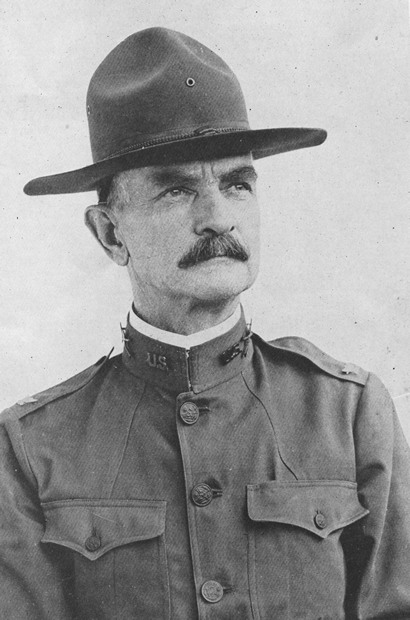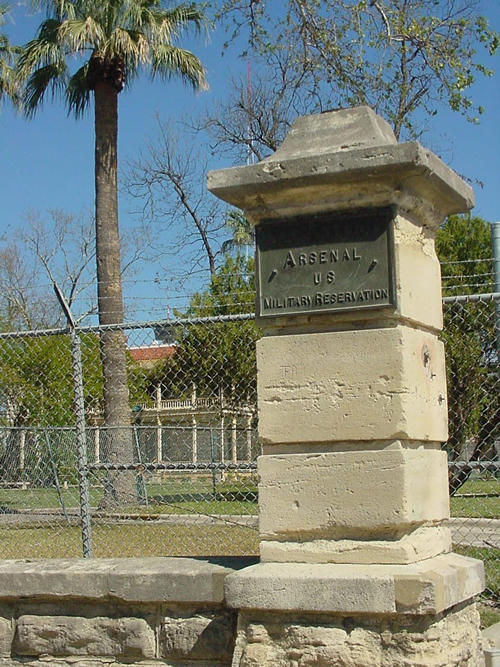|
|
Texas
| Features | World
War I
An Abbreviated
and Incomplete
History of the 19th Infantry Regiment
They fought the
British, Rebels, Indians,
Spanish, Mexicans, Philippine Insurgents,
Hurricanes, Blizzards, Malaria (and maybe Elliot Ness)
by John
Troesser
(RA 14884897)
The 19th Infantry
Regiment
&
Private Dennis Buchicchio
|
| The flag of
the 19th Infantry Regiment that was flown over Veracruz |
Formed
a mere 16 days after the War of 1812 was declared, the 19th Infantry
originally served under the command of General Winfield Scott. During
this conflict, the 19th participated in the Battle of Niagra, the
attack on Fort Mackinac and the Battle of Fort Erie. At the close
of the war (1815), the 19th was consolidated with other regiments
to form the 3rd U.S. Infantry Division.
During the Civil War elements of the 19th saw action at Shiloh, defended
Washington against a threatened attack in 1862, participated in the
battle at Murphreesboro and Chickamauga and were present at Antietam
(but not engaged).
During Reconstruction the 19th was stationed in towns across Arkansas
and in the 1870s, elements of the 19th guarded wagon trains to Fort
Supply and Fort Dodge, Kansas while others guarded the railroad. Units
fought Indians at Sappa Creek and others were caught in a blizzard
outside of Fort Wallace, Kansas in January of 1875.
In 1879 the 19th's commanding officer, Lt. Col Lewis received a fatal
wound in a skirmish with Indians fighting under Chief Dull Knife.
The 19th took part in the last major campaign against the Indians
and then various companies of the 19th were scattered to lonely outposts
throughout the West waiting for the next fight which didn't take place
until the USS Maine blew up in Havana harbor.
During the Spanish-American
War, the 19th was one of the first units dispatched. Transported
by train to Mobile and then Tampa, on July 21st the regiment boarded
the USS Florida and USS Cherokee to set sail for what was then called
"Porto Rico." They spent a year in Ponce performing guard and provost
duty, then sailed to New York where they boarded trains to the west
coast. On July 27, 1899 they sailed for Manila.
The regiment was broken into company-sized units and participated
in many battles with the Insurgents before returning to the U.S. in
1902. They served a second tour in the Philippines from 1905 to 1907
and a third and final tour from February 1910 to May of 1912.
On April 23rd, 1914, the regiment was made part of the Fifth Brigade
under General Frederick
Funston - an American hero from his actions in the Philippines
and for being "The Man who saved San Francisco" during the 1906 earthquake.
They were with Funston
when he briefly occupied Vera Cruz, Mexico after a "misunderstanding"
between the U.S. Navy and Mexico. After that they were then sent back
to Galveston
- where they had been quartered prior to the Mexican occupation. There
at Galveston they were battered by the hurricane of August 15, 1915.
The camp was destroyed and the 19th was again split up with some companies
being dispatched to Fort Sill, Oklahoma and other units to Fort
Sam Houston in San
Antonio.
In the fall of 1917 the third battalion of the 19th was sent to Goose
Creek, Texas (now included in greater Baytown)
to quell a riot by oil field workers. After the strike was settled,
the 19th won praise from the oil worker's union for their fairness
in dealing with the strikers. The president of the union even requested
that "if the Government intends to keep troops here, why can't it
be the 19th Infantry?" |
 |
Colonel Robert
C. Williams
(West Point Class of 1886) |
During
WWI the 19th was again scattered -
but their Headquarters was in the newly formed Camp
Travis, just north of San
Antonio's Fort Sam. Company 'A' was camped on San
Antonio's South Flores Street - guarding the Army's warehouses
and the U.S. Arsenal. The 19th provided men for other units that were
reorganizing for Europe. *(See correction
below.)
In 1918, the 19th's commanding officer Col. Millard F. Waltz, was
given a retirement parade in downtown San
Antonio, not far from the Arsenal grounds. Col. Waltz was replaced
by Colonel Robert C. Williams (West Point Class of 1886).
(*Correction: "I checked some of
the soldiers' names listed. They were not on the troop transport passenger
lists going to Europe with the 90th.
The 19th Regiment were garrison troops that never left the US. As
indicated above, they were scattered, some of them guarding warehouses
and an arsenal in San Antonio, TX. John B. Milam, October 03, 2019) |
 |
A gatepost at
the former U.S. Arsenal in San Antonio
TE Photo
March 2006 |
Private
Dennis Buchicchio of the 19th Infantry Regiment
Photos courtesy of his son, Raymond Buchicchio,
Roselle, Illinois, who spent 29 months riding a destroyer in both
Atlantic and Pacific Theaters of War during the Second World War..
Our thanks to Mr. Buchicchio for providing the photos and the Regimental
Roster for the 19th Regiment which have since been forwarded to Fort
Sam Houston's library. - Editor |
|
|
Private
Buchiccio in dress uniform 1918
Motorcycle Messenger of Company "B" |
| Private DB poses
on cycle with sidecar. Inscribed on back: "Come on Katie, let's go
for a ride. I am starting the machine." |
| A dapper Private
DB in gloves and garrison cap. 1918 |
| Civilian Dennis
Buchiccio back home in Chicago on a civilian motorcycle. |
Al
Capone's Triggermen?
The
organization of the Army and its various units have evolved over time.
In 1918 Army battalions had "Machine Gun Companies." It is interesting
to note that the roster of men from the 19th Infantry Regiment's Machine
Gun Company were mostly recruits from Chicago, Illinois.
Of the 147 enlisted men, 114 were from Chicago (five more were from
NYC). All of the men were Privates except for one Corporal and a single
"First Class Private" as they called PFCs back then. The NCOs were
mostly from northern states (Michigan, Iowa, and Pennsylvania) with
a sprinkling from the South (Kentucky and South Carolina). A single
Sergeant was from San Antonio.
Among the Privates there were only four other Texans. One each from
Bertram,
Gardner, San Antonio
and Amarilla [sic].
Assuming these men were discharged after the war (to become "The Forgotten
Men" of the Great Depression), they would've still been in their prime
during Prohibition. Imagine looking for a job in Chicago when the
only piece of equipment you could operate fired bullets? Who in Chicago
was hiring machine-gunners during the 1920s?
The following names are from the 19th Infantry's Machine Gun Company's
roster: Vincenzo Castrogiovanni, Pietro Castronovo, Fernand Delaune,
Nicholas Delirigio, Vincenzo Di Gaetano, Vito Forges, Carminio Ianone,
Cesare Palma, Natale Porcelli, Bruno Ritacco, and Jimmy Romegnano.
There's not enough evidence to prove that they were later employed
by Mr. Capone, it makes an interesting historical supposition.
© John
Troesser
June,
2006 |
| Anyone wishing
to share stories or photos of their fathers, uncles, grandfathers
or great grandfathers that served in Kansas, Mexico, the Philippines,
or Goose Creek, please contact
us. |
|
|
